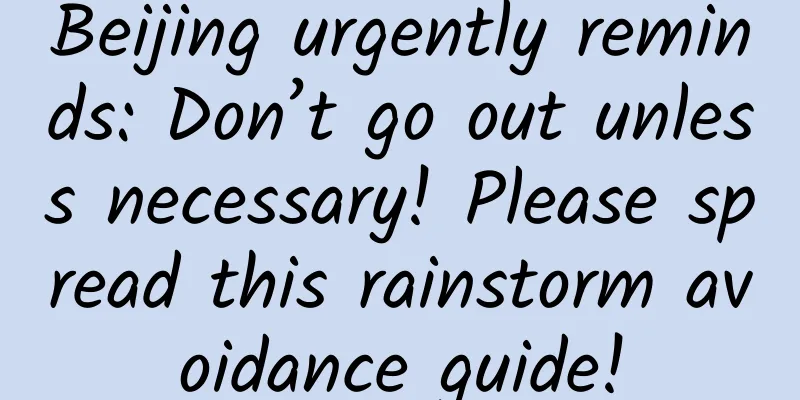Beijing urgently reminds: Don’t go out unless necessary! Please spread this rainstorm avoidance guide!

|
The Central Meteorological Observatory continued to issue a red warning for heavy rain at 6:00 on July 30: It is expected that from 8:00 on July 30 to 8:00 on July 31, there will be heavy to torrential rain in Hebei, Beijing, Tianjin, central and eastern Shanxi, northern Henan, central and western Shandong, etc. Among them, there will be heavy rainstorms in parts of central and southern Hebei, central and southern Beijing, western Tianjin, eastern Shanxi, etc., and extremely heavy rainstorms (250-400 mm) in parts of the mountainous areas in central Hebei and southwestern Beijing. There will be heavy rain or rainstorms in parts of central Anhui, eastern and southern Hubei, northern Hunan, northern Guizhou, southwestern Yunnan, and northern Jilin. Beijing launches citywide red (level 1) flood warning response Citizens should not go out unless necessary At 17:30 on July 29, Beijing issued a red warning signal for heavy rain. At 19:00, the Beijing Flood Control Headquarters launched a city-wide red (level 1) flood warning response. Six major warning signals including heavy rain and mountain torrents were issued simultaneously, and precautions should be taken. Weather forecasts show that from the night of July 29 to the night of August 1, Beijing will see heavy rain, with particularly heavy rain in the west and south. The main rainfall process will occur from 2:00 on the 30th to 20:00 on the 31st, with heavy rain in the whole city, and particularly heavy rain in parts of Fangshan, Mentougou, Changping, Haidian, Shijingshan, Fengtai, Yanqing, Daxing, Tongzhou, Xicheng, Dongcheng, and Chaoyang. The Beijing Hydrological Center issued an orange flood warning at 0:00 on July 30: It is predicted that Beijing will have heavy to extremely heavy rain from July 30 to August 1. Orange warning level floods may occur in the Beiyunhe Basin, and yellow warning level floods may occur in urban rivers, the Yongding River Basin, and the Daqing River Basin. The Beijing Flood Control Headquarters reminded the general public not to go out unless necessary. Enterprises and institutions, except for ensuring the operation of the city and people's livelihood services, do not require employees to go to work unless necessary. Many scenic spots in Beijing have issued temporary closure notices Two subway stations have been closed The Palace Museum issued a temporary closure notice on the evening of the 29th. To ensure the personal safety of visitors, the Palace Museum will be closed on July 30 and 31. The opening hours will depend on the rain. Beijing Planetarium and Beijing Ancient Observatory will be temporarily closed from July 30 and the reopening time will be notified separately. The Beijing Oceanarium announced on the evening of the 29th that the Beijing Oceanarium will be temporarily closed from now on, and the opening hours will depend on the rain conditions. In addition, according to incomplete statistics, Tiananmen Square, Lama Temple, Beijing Universal Studios, Badaling Great Wall, Simatai Great Wall Scenic Area, Juyongguan Great Wall Scenic Area, Yudutshan Scenic Area, and the Summer Palace are currently temporarily closed. Heavy rain Travel safely Don't panic in an emergency This risk avoidance self-help guide Be sure to remember it! Heavy rainfall in summer leads to frequent natural disasters Such as mountain torrents, mud-rock flow, landslide, collapse, typhoon, etc. If a disaster occurs Do you know how to escape danger? What other precautions should be taken? 01 If you encounter a flash flood, never swim to escape Flash floods are floods that rise and fall suddenly in mountain streams. Because the ground and riverbed slopes in mountainous areas are relatively steep, runoff and confluence are relatively fast after rainfall, forming a rapidly rising and falling flood peak. Flash floods are characterized by strong suddenness, concentrated water volume, and strong destructive power. Self-help methods : When a flash flood arrives, people who do not have time to evacuate should quickly move to nearby hillsides, highlands, buildings, flood shelters, etc., or immediately climb to roofs, high floors of buildings, big trees, high walls and other high places for temporary shelter. If the flood continues to rise, make full use of the prepared life-saving equipment to escape, or quickly find some door panels, tables and chairs, wooden beds, large pieces of foam plastic and other floating materials to make a raft to escape. If you are surrounded by floods, try to contact the local government and flood control command department as soon as possible, report your location and danger, and actively seek rescue. Never try to swim to escape and do not climb live electric poles or towers. 02 When encountering a landslide, the direction of escape is very important A landslide is a phenomenon in which a part of rock and soil on a mountain slope moves downward as a whole under the action of gravity, commonly known as "mountain sliding" or "ground sliding". Before a landslide occurs, some abnormal phenomena in the surrounding environment can be used as a sign of an impending disaster. For example, cracks appear on the walls of houses and continue to expand, doors and windows suddenly cannot be opened, trees and electric poles on the hillside become crooked, muddy springs flow out at the foot of the slope, and mice run around without entering their holes. These are all signs that the soil on the slope is moving downward. It should be noted that collapse is a geological phenomenon in which the rock and soil on a steep slope suddenly collapses, rolls, and accumulates below the slope. Landslides and collapses often occur together, and areas prone to landslides are also prone to collapses. Collapses and landslides can contain or transform into each other. Self-help methods: When encountering a landslide, if you are on top of the landslide body, you should quickly escape to the rear or sides, and do not run down the mountain in the direction of the rolling stones. When on a landslide, you should quickly look around and evacuate to a safer area. When running away, you should run to the sides and not to the top or bottom of the landslide. When you are in the middle of a landslide and cannot escape, you should find an open area with a gentle slope to stay in, or hold onto a big tree or something, but be sure not to get too close to houses, walls, electric poles, etc. When you are at the front of a landslide or under a collapse body, you can only escape quickly to both sides. After the landslide stops, you should not return to check the situation immediately, because landslides can occur continuously, and if you return hastily, you may be damaged by a second landslide. 03 Encountering a mudslide Don't let the mudslide chase you If mountain torrents form solid runoff, it is called a debris flow. The time pattern of debris flow in China is consistent with the time pattern of concentrated rainfall, and has obvious seasonality. It usually occurs in the rainy summer and autumn seasons. Therefore, try not to stay in the valley for a long time during the rainy season. Self-help methods: When hiking along a valley, if you encounter heavy rain, notice unusual sounds in the valley or hear an alarm, run to an open area to avoid being buried as much as possible. Immediately run to solid high ground or the hillside beside the mudslide, and do not stay in the valley. You must immediately climb up the hillside that is perpendicular to the mudslide. The higher you climb, the better; the faster you run, the better. You must never escape in the direction of the mudslide. If you plan to camp in a valley where a mudslide may occur, you should choose a flat high ground as your campsite, and try to avoid the slopes with rolling rocks and large amounts of debris, especially not camping at the bottom of valleys or ditches. Heavy rain is coming Please be careful! Comprehensive sources: Xinhua News Agency, CCTV News, Science and Technology Daily, Beijing News, etc. |
<<: Science and technology illustration | Adding technology "wings" to cultural relics protection
Recommend
Master this and you can also write high-conversion copy!
If we observe carefully, we will find that now ad...
APP operation: How to improve user retention rate?
There is an important data indicator in the produ...
The top 10 mobile technologies to look forward to in 2021
2021 has just begun, and Xiaomi and vivo have alr...
Yuncheng Mini Program Development Company, how much does it cost to make a book mini program?
Yuncheng Mini Program Development Company, how mu...
The National Health Commission has issued a guideline for the diagnosis and treatment of monkeypox. Monkeypox virus can be inactivated by doing this
Xinhua News Agency, Beijing, June 15 (Reporters X...
Zhihu Marketing Methodology in 2019!
According to the data from the "iiMedia Repo...
How much is the first recharge for Baidu promotion in Suzhou?
The general price is 6200, in some areas it is 74...
APP promotion and operation: a complete analysis of the user growth system!
The user growth system is a mechanism that record...
Software to add a small Santa hat to the avatar online_source code library, software
All ads are removed for a clean and refreshing ex...
"Scientific" Rumor List in February 2025: Can "Spring Fasting" achieve "Quick Weight Loss"?
The list of "scientific" rumors in Febr...
iOS development: Inducing users to comment on your app
"Since my own app has few downloads and comm...
The Sea Lion 07 EV is on the market. In addition to demonstrating pricing power again, what else can the e-platform 3.0 Evo bring?
How strong is BYD? It has representative models i...
DeepMind's latest research: AI beats humans and designs better economic mechanisms
“Many of the problems facing humanity are not sim...
Beware! Chronic fatigue syndrome may bring big trouble! Check to see if you are affected →
Have you ever been extremely tired in your life, ...
How to overcome the "underwater trap" and conduct anti-mine warfare? Why do unmanned platforms have unique advantages?
Mines have the characteristics of good concealmen...



![Luo Yao's Graphic Design Thinking Course ended in March 2020 [HD video only]](/upload/images/67cbfd8b409f6.webp)





